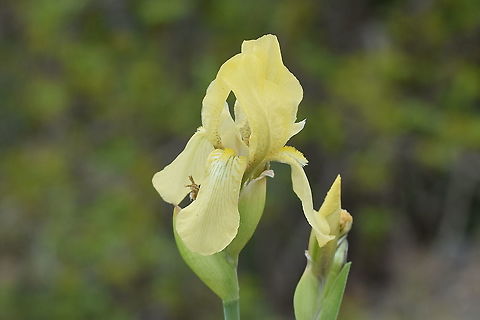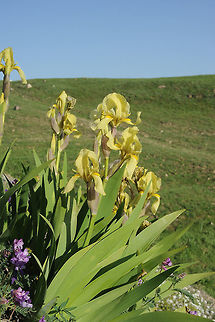
Appearance
It is similar in form to ''Iris taochia'', ''Iris schachtii'' and the yellow form of ''Iris purpureobractea''. It is also similar to ''Iris albertii'', but with yellow flowers.It as a stout rhizome, that can form dense clumps of plants.
It has deciduous , erect, ensiform, yellow green, or light green, or grey-green leaves. The outer and first leaves, are normally very blunt and rounded. This led to early specimens of the plant were renamed at Kew as ''Iris obtusifolia'', this was later classified as a synonym of 'Iris imbricata' The broad leaves, can grow up to between 30–40 cm long, and between 2 and 3 cm wide.
It has a slender stem or peduncle, that can grow up to between 30–60 cm tall.
The stem has oval, or oblong shaped, green, or pale green, inflated, spathes . They are also tightly imbricated, or overlapping, and transparent, or membranous at the tip of the bract. They look similar in form to translucent green pea pods.
The stems hold numerous, between 2 and 5 flowers, in spring or summer, between April and May, May, or between May and June.
The large, flowers are 7–10 cm in diameter, They are larger than ''Iris flavescens'' , and another yellow flowering iris. They come in shades of yellow, from pale yellow, greenish yellow, to bright yellow, or sulphur yellow. Very rarely, there is a purple form, and also blue forms, were noted by Rodionenko.
Like other irises, it has 2 pairs of petals, 3 large sepals , known as the 'falls' and 3 inner, smaller petals, known as the 'standards'. The falls are obovate or cuneate shaped, and 5–6 cm long. They often curl under, or are reflexed. They have 'hafts' that are veined with brown, or brownish purple. In the centre of each of the falls, is a white beard tipped with yellow, or yellow, or dark yellow beard. The standards are obovate, and broader than the falls.
It has style branches that are 2.54 cm long. It has a short perianth tube, at under 2.54 cm long. After the iris has flowered, it produces a seed capsule, in late July. The capsule and seeds have not been described.
Habitat
It is native to temperate regions of Asia. It grows within the valleys, of mountains, in damp grassy meadows, on scree slopes, and beside mountain streams on steep banks.They can be found at an altitude of 800–3,000 m above sea level.
Defense
Like many other irises, most parts of the plant are poisonous, and if mistakenly ingested can cause stomach pains and vomiting. Also, handling the plant may cause skin irritation or an allergic reaction.References:
Some text fragments are auto parsed from Wikipedia.
